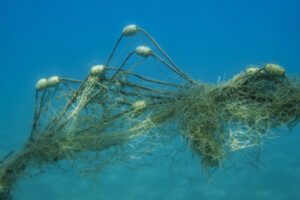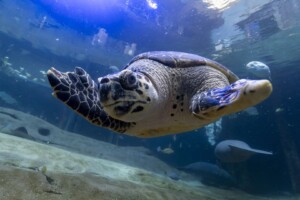Jenny Gray, the formidably able CEO of Zoos Victoria, combines an impressive corporate background with a genuine passion for conservation.
Her move from the corporate sector into the zoo world – she was CEO of the electronic banking division at FNB Corporate Bank- was the result of an epiphany when, disillusioned  with making money for rich people with whom she didn’t share a value system, she realised she would prefer to be using her abilities to do some good in the world.
with making money for rich people with whom she didn’t share a value system, she realised she would prefer to be using her abilities to do some good in the world.
An opening at Johannesburg Zoo was her opportunity and now, as CEO of Zoos Victoria – which comprises Melbourne Zoo, Healesville Sanctuary and Werribee Open Range Zoo – Jenny Gray has been engaged in bringing a business eye to bear on the process of conservation, overseeing a radical change of direction and demonstrating in the process that the twin functions of conservation and visitor attraction do not have to be conflicting, as long as heartfelt campaigns are regulated by incisive business protocols.
Her expertise in the fields of infrastructure and finance have made her ideally suited for the task of making conservation and the fighting of extinction a viable, but core function of what are now referred to, under her aegis, as ‘conservation organisations based at zoos’ rather than simply zoos.
The visitors you don't get today you don't get tomorrow
She points out that her work with the Durban Bus Company (she was responsible for the merging of a black and white bus service in Durban after the fall of apartheid, a merge achieved without any industrial action or loss of passengers – something that involved people skills, financial acumen and people management) was a good preparation.
“It was very similar: both are a public service heavily subsidised by government, and the visitors you don’t get  today you don’t get tomorrow. It’s actually the same business model.”
today you don’t get tomorrow. It’s actually the same business model.”
Her work in the transport sector gave her an in-depth competence with infrastructure, and her background in finance meant she could bring strong fiscal management skills to bear.
She said, “The thing I knew least about was animals – but I have a whole staff that knows all about animals.”
It has been suggested – by the international zoo consultant David Hancocks, for example – that the role played by zoos in government-based wildlife conservation programmes is cosmetic and superficial and that museums could just as easily draw attention to the plight of endangered species.
But Jenny is adamant that the Zoo offers two unique capabilities: the skills and resources to handle and breed animals in captivity, and 2 million people each year walking through the gates and absorbing the multiple messages about how they can make a difference.

Conservation Organisations Based at Zoos
Conservation is the core business of zoos, and every visitor through the gates; every internet witness to its campaigns, is a potential convert to the cause, and a potential fighter in the battle against extinction.
On her iPad, Jenny has a recording of the call of the last surviving Christmas Island Pipistrelle, a small bat, the only call picked up from 500 monitors placed around Christmas Island in 2009. After a few days, the call ceased.
The effect on audiences as the recording falls silent is profound as they realise they are listening to an extinction event: the first extinction of an Australian mammal in 60 years.
It was after this event that that Zoos Australia asked scientists which Victorian animals were heading for extinction over the next ten years, and the scientists came up with 16 species. The resulting captive breeding program, costing about $2.5 million a year, forms the basis of the zoo's undertaking that ''no Victorian terrestrial vertebrate species will go extinct on our watch''.
The zoo has successful captive breeding programmes, including a population of Tasmanian Devils which may well need to replace the wild population, rapidly being wiped out by a devastating contagious – and so far, incurable – facial cancer. There are also the ‘ark’ species, necessarily perpetuated in captivity as they no longer have a wild habitat to which to return.
Which Animals should be kept at the Zoo?
But apart from species held at the zoo for their own survival, in a world where the keeping of wildlife in captivity is increasingly controversial, how are decisions made on which animals should be kept in the Zoo?Jenny is clear that every animal in the Zoo has to have a good reason for being there.
Zoos Victoria has developed a Species Selection Tool, which looks at two axes: value, in terms of conservation and the contribution the animal will make, and cost – or the effort of keeping it in captivity. “With some animals, the effort or the cost to the animals is too high and we just wouldn’t keep them at all…”
There are five different categories:
- ‘Recovery’ species;
- ‘Ark’ species;
- ‘Ambassador’ species – (“a species linked to one of the campaigns we’re running – for example, for our campaigns on palm oil we use orang-utans as an ambassador species: people engage with and care about the orang-utans and then they’re happy to take the action we ask them to take around palm oil”);
- ‘Enabling’ species ( “species that create the environment that mean you want to come to the zoo. If your zoo has no good animals – well, there’s nothing that enables us even to talk to you about the conservation messages…Something like meerkats – they’re not endangered in the wild, but they are incredibly engaging – what we’d call an ‘enabling’ species.”); and finally –
- ‘Research’ species. (“If there’s a highly endangered frog, for instance, you don’t want to learn all your lessons on the last twenty. So you work with a more common animal and build up your skills, then bring in the endangered frog at a later point. That’s what we would call a research species.”)
She explains, “So: you want a balance. You want some species to attract visitors; some to give them a great day out; the ones that mean they leave going: ‘Wow…’; that will start a conversation that leads to thinking about animals and the environment.”

Reconciling entertainment and conservation
The charismatic Tasmanian Devils, “fulfil so many of these different functions. They’re already a recovery species; they’re great ambassadors for the wild altogether and they’re engaging. If you can get multiple interactions, that’s obviously a better way of doing it.”
Conservation may be the primary concern, but in order to keep visitors – and their wallets – flooding through the gates then the three zoos that make up Zoos Victoria must also operate as great places for a family day out. On the face of it, conservation and wholesome family entertainment are two very different matters. So how can the twin functions be reconciled?
Clearly, Zoos Victoria has managed to do so: visitor numbers are increasing steeply and campaigns such as “Don’t Palm Me off” are having a global impact.
Zoos Victoria is a government state-owned entity, and the Victoria government contributes a subsidy, which means the admission fee can be kept down to an affordable price ensuring plenty of visits and school groups, and that children can be admitted free at weekends, on public holidays and during school holidays.
Admissions through the gate are a clear revenue stream, as are annual memberships, which have doubled in the last four years: there are now over 150, 000 annual members who not only visit regularly, but who engage with the animals and in the campaigns. Further income sources are twilight trails, zoo sleepover safaris, behind-the-scenes visits, merchandise, catering and fund-raising. There is a philanthropic arm that raises around three million dollars a year, and that figure is growing.
In terms of value, all Zoo undertakings are assessed according to a ‘value – effort’ matrix whereby a low effort-high value project is worthwhile; a high-effort, high value project might occasionally be worthwhile; a low effort, low value project is probably not worth doing and a high effort, low value action should be avoided. Each undertaking must have a conservation outcome; a visitor impact; it must make a profit and it must be good for the Zoo’s public profile.

Wipe for Wildlife
Zoos Victoria has instigated some hugely successful conservation campaigns, including the ‘Don’t Palm Me Off campaign drawing attention to the plight of wildlife and fronted by orang-utangs devastatingly affected by the intensive palm oil industry, and the wonderful Wipe for Wildlife campaign promoting the use of recycled toilet paper. The impact of this campaign was impressive. The Zoos used a comedian to launch the initiative and, as with all campaigns, worked with the university to measure the outcomes.
“On that one, after one visit, 30% of non-users switched to recycled toilet-paper. After just one interaction… Now, that’s just remarkable.”
She adds, “We got a partnership with a manufacturer [of recycled toilet paper] who gave us free toilet paper for a year, and that more than covered all the costs of the campaign.”
This is an important consideration. “When we go into conservation campaigns we also look to see that the campaign is sustainable and can make money in its own right. We make sure there’s a benefit back into the business model.”
An example of this is the ‘Beads for Wildlife’ campaign, which promotes alternative revenue streams for women in Kenya through selling their beadwork.
The Zoos make large profit on the sales, and the Kenyan women are supported.

“It’s very much a respectful commercial partnership…We’ve bought over half a million dollars worth of beads from them. Now, we would never have sent them half a million dollars worth of charity. But by this being a sustainable partnership, we both keep making money. And the beads are now our biggest seller after plush animals… And the huge success in Kenya has been more schools opening up; more kids are in school; fewer domestic animals are competing with wildlife for resources. Those are the kinds of programmes we want to work with: the ones that make money AND do conservation. Those are the kinds of models we’re looking for.”
There is a complete integration of conservation objectives into every aspect of the Zoos.
“Everything. It’s not always easy. They’re now making me drink Free Trade coffee, which is… absolutely the right thing to do.”
All staff drive hybrid cars; all paper products on the sites are made of recycled paper, and the buildings have gone onto solar power.
Making conservation part of everything you do
“If we’re going to be a conservation organisation, it’s about being absolutely serious about it. We are the world’s first carbon-neutral zoos… and we’re now going to reduce our carbon footprint every year.”
She has designated Zoos Victoria a ‘zoo-based conservation organisation’, moving away from the sometimes negative connotations of the word ‘zoo’.
“The challenge of the term ‘zoo’ is that there are 10, 000 zoos, some of which are horrible roadside attractions.”
An impassioned advocate of conservation and a compelling public speaker with a gift for enlisting the empathy of the listener, she speaks internationally to zoo boards and strategic teams on the subject of what becoming a zoo-based conservation organisation means and how to implement the necessary changes.
“…And it’s catching on. It’s such a no-brainer when people hear it. Zoos have been supporting conservation for a long time: this is just the next step – making it part of everything you do instead of just something you support with money.”
Her belief is that as we, as humans made this mess, it is within our power to clean it up. We just need to want to.
All images kind courtesy Zoos Victoria.














